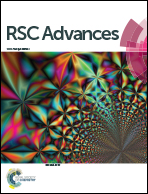Adsorption of imidazolium-based ionic liquids with different chemical structures onto various resins from aqueous solutions†
Abstract
The increasing application of ionic liquids (ILs) in many fields has led to significant attention towards their treatment before they enter the environment to prevent their potential environmental harm. In this work, a series of imidazolium-based ionic liquids with different chemical structures were selected to study their adsorption onto various resins from aqueous solutions. The results showed that the functional groups in the resin played a predominant role for the adsorption of the ionic liquids onto the resins, and the adsorption capacity of the resins for the ILs decreased following the sequence sulfonic acid > carboxylic acid > without any functional groups. The variation of the anion of the ILs had a slight effect on the adsorption capacity of the ILs onto the resins, but the adsorption capacity increased with increasing alkyl chain length of the imidazolium cation. The results provide an understanding of the adsorption behavior of various ILs onto different resins, and guide the removal, separation and/or recovery of different ILs from aqueous streams by resins or other sorbents.


 Please wait while we load your content...
Please wait while we load your content...